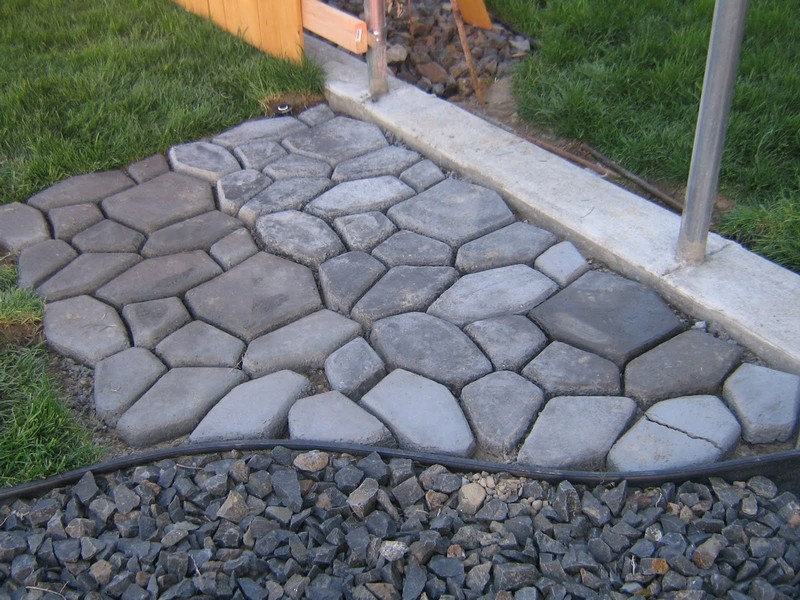
Gardens are not just about plants and flowers, it’s also great spaces to enhance because you can do many things to them. You can build an outdoor grill area or fireplace, a wishing well, or a small playground for the kids. But if you have the space for these things then you can make one more useful addition to your garden – a pathway!
Stone paths are not only functional, they can be decorative as well. You can enjoy going around your garden without sinking your shoes into the soft ground after it has rained. You can place it anywhere, at the sides or it can cut across the grass, depending on the design layout you have in mind for your garden.
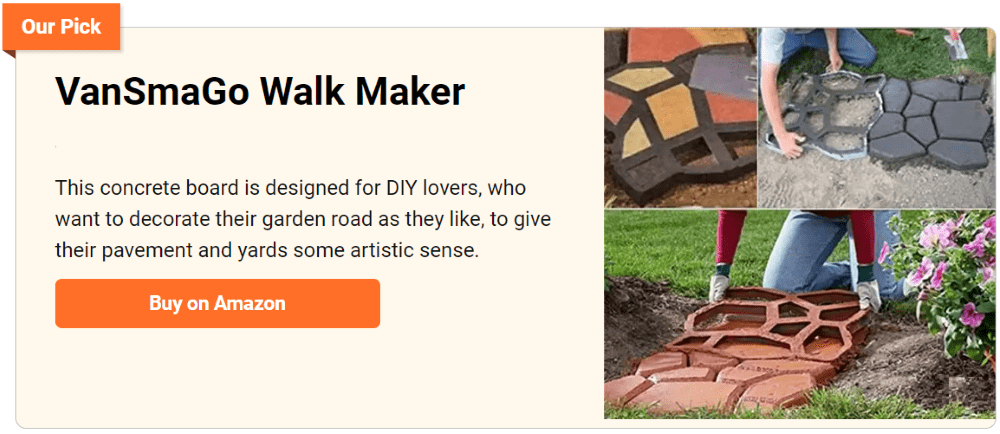
Stone paths are aesthetically pleasing to the human eye, and add form, flow, and function to the landscape. They provide a pathway for pedestrians & animals.
Stone is sturdy and durable. Stone paths are also uniform and aesthetically pleasing. They have the benefit of easy maintenance. They are resistant to the growth of weeds and moss and can be easily hosed clean.
But if you don’t have access to beautiful stones for your stone path, you can use a cobble stone path. This pathway is a great way to add character and charm to your home’s landscaping.
A cobble stone path is a crowd favourite, and having a stencil could make your project a lot easier!
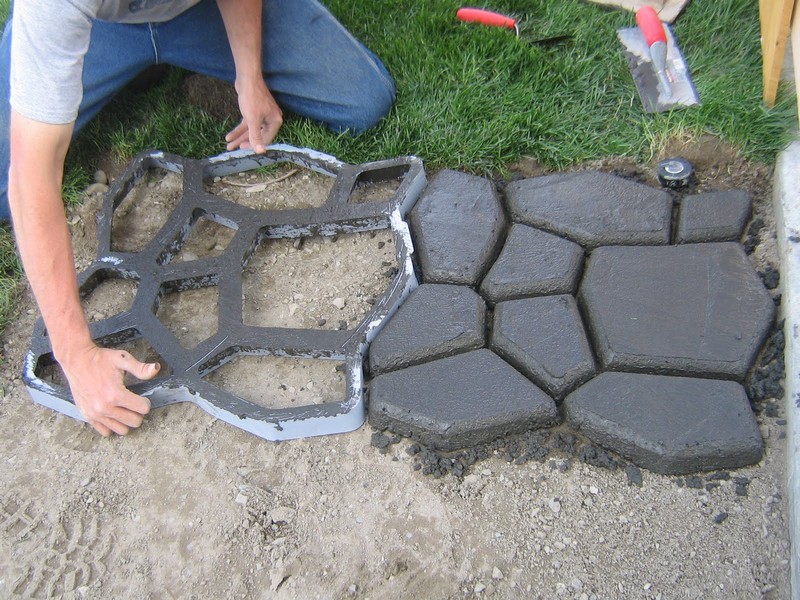
Cobble stones date back to ancient times. In Europe, archeologists have unearthed cobbled stone paths dating back to the 3rd and 4th centuries. People have been using cobbled walkways throughout history and are still in use and lovingly maintained in many gardens today.
These pathways were once the only way to travel, and they were used by everyone from royalty to peasants. Today, we can still see these kinds of pathways in many old gardens and parks. They are a beautiful reminder of the past, and they are still enjoyed by many people today.
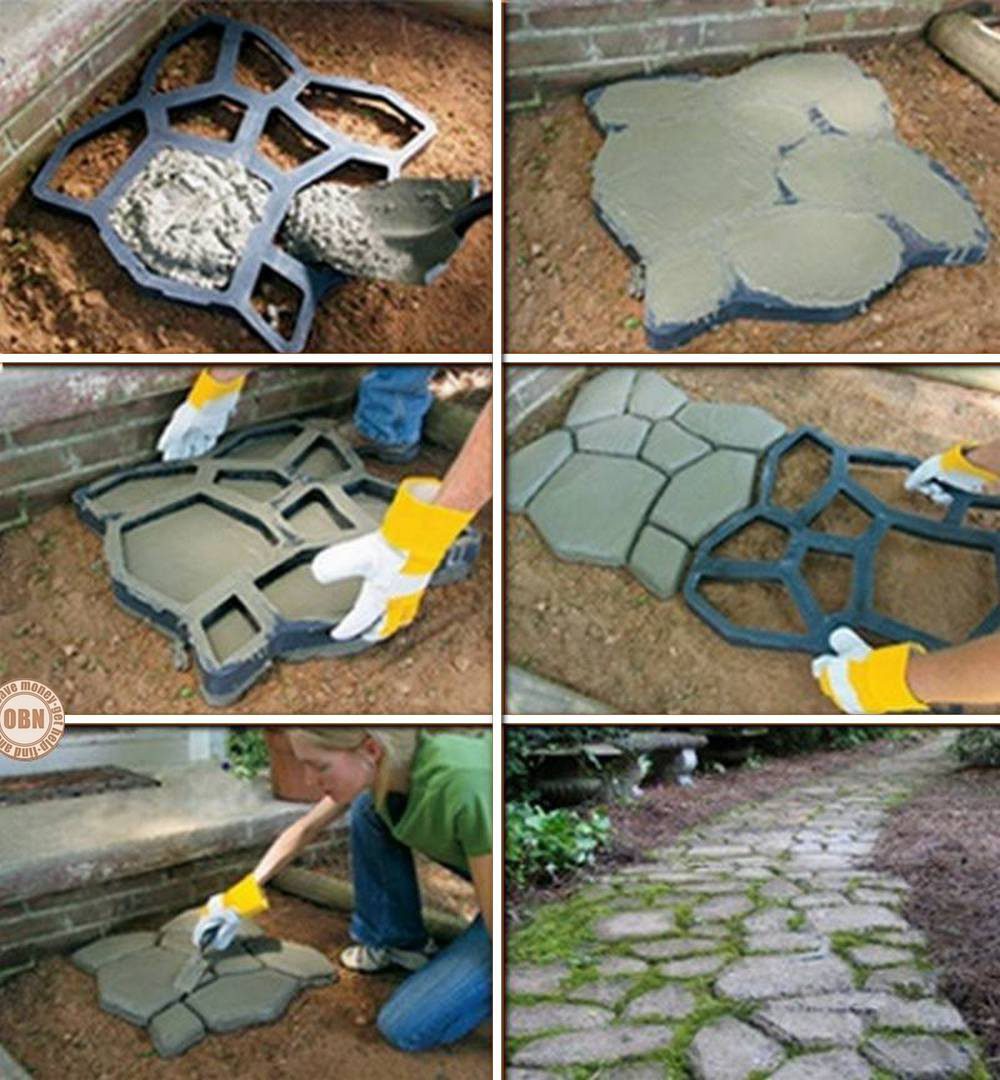
What are the materials needed to create a DIY cobble stone path?
This DIY cobble stone project can be done over a weekend, including the drying period and you can ask your partners to help you with it.
Adding some colouring to the cement can also enhance the look of your stone path. Do you think this kind of stone pathway would suit your garden?
You’ll need these materials:
- Quikrete Stencil
- Quikrete Cement Colour
- Wheelbarrow
- Gloves
- Protective Mask
And this tool:
- Trowel
How to create a DIY cobble stone path?
1. First, prepare your Quickrete stencil.
- A Quickrete stencil is a template that is used to create or imprint patterns in concrete. Quickrete stencils are made from a thin, flexible material that can be reused many times.
2. Prepare the area where you will be working.
- Clear away any loose debris from the area where you will be working. This will help you to create a safe and clean workspace.
3. Apply a layer of Quickrete bonding agent
- Apply a layer of Quickrete bonding agent to the area where the stencil will be placed. Make sure that the bonding agent is spread evenly over the surface before proceeding.
- Once the bonding agent is in place, carefully position the stencil on the surface and smooth it down so that it is completely flat.
4. Now you are ready to begin applying the Quickrete.
- Begin by pouring a small amount of concrete onto the stencil. Use a trowel to spread the concrete evenly over the quickrete.
- Make sure to go over the entire surface area so that the concrete is level. Once you’re finished, use a brush to smooth out the surface of the concrete.
- The concrete will then take on the shape of the stencil.
Click on any image to start the lightbox display. Use your Esc key to close the lightbox. You can also view the images as a slideshow if you prefer 😎
A stencil will make this project easier…
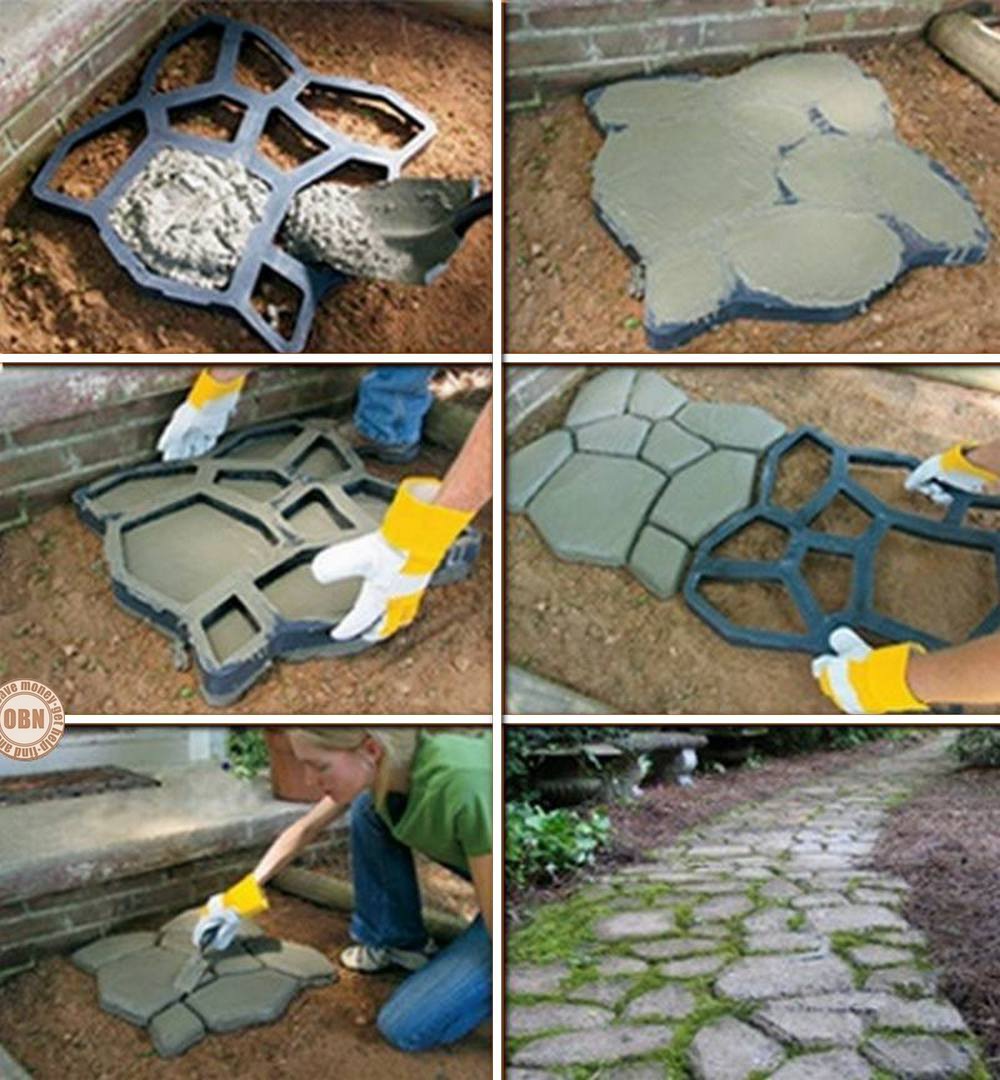
Want that stencil? Just click here…
Thanks to Tancamjenksfam for this great project. You can get step-by-step instructions here…
If you liked this project, you can find more DIY stepping stones and pathway projects here…
Exploring 5 Stunning DIY Cobble Stone Path Designs
Cobble stone paths represent a timeless addition to outdoor spaces, combining functionality with aesthetic appeal. Whether leading through a garden, connecting different areas of a backyard, or adorning the entrance to a home, cobble stone paths offer durability and charm.
In this guide, we will delve into five sturdy DIY cobble stone path designs, exploring their unique features, benefits, and installation methods. From classic elegance to rustic whimsy, these designs inspire enhancing outdoor landscapes with enduring beauty.
1. The Classic Herringbone Path
The classic herringbone pattern is a hallmark of sophistication and timeless elegance. Rectangular cobble stones are laid in a diagonal pattern, creating a visually striking zigzag effect that adds a touch of refinement to any outdoor space.
Features:
- Rectangular cobble stones arranged in a herringbone pattern.
- Symmetrical layout with clean lines and crisp edges.
- Ideal for formal gardens, traditional landscapes, or pathways requiring a touch of elegance.
Benefits:
- Provides excellent traction and stability.
- Enhances the visual appeal of the landscape with its timeless design.
- Requires minimal maintenance once installed, making it a durable and long-lasting option.
2. The Whimsical Mosaic Path
A mosaic cobble stone path adds personality and charm to outdoor environments. Irregularly shaped stones are arranged in intricate patterns or designs, allowing for creative expression and customization that reflects the homeowner’s unique style.
Features:
- Irregularly shaped cobble stones arranged in mosaic patterns.
- Endless design possibilities, including geometric shapes, floral motifs, or abstract art.
- Offers a playful and artistic touch to gardens, courtyards, or pathways seeking a whimsical aesthetic.
Benefits:
- Adds character and visual interest to the outdoor area.
- Allows for personalization and creative expression in design.
- Can be made using recycled or reclaimed materials, contributing to sustainability efforts.
3. The Rustic Stepping Stone Path
A rustic stepping stone path exudes a natural and organic feel, blending seamlessly with its surroundings. Irregularly shaped cobble stones are spaced apart, creating a casual and informal pathway that invites exploration and discovery.
Features:
- Irregularly shaped cobble stones arranged in a loose, random pattern.
- Natural spacing between stones, allowing for grass or ground cover to grow between them.
- Provides a rustic and charming addition to cottage gardens, woodland landscapes, or backyard retreats.
Benefits:
- Blends harmoniously with natural landscapes and garden settings.
- Creates a relaxed and inviting atmosphere for strolls.
- Allows for flexibility in layout and design, accommodating uneven terrain or curved pathways.
4. The Tranquil Zen Garden Path
A Zen garden cobble stone path promotes tranquility and mindfulness, offering a serene retreat within the landscape. The pathway features a minimalist design, with simple lines, subdued colours, and carefully selected elements such as rocks, gravel, and moss.
Features:
- Straight or gently curved pathway with minimalistic cobble stone layout.
- Surrounded by Zen garden elements such as rocks, gravel, sand, and moss.
- Designed to encourage meditation, contemplation, and relaxation.
Benefits:
- Creates a peaceful and calming atmosphere in the outdoor space.
- Promotes mindfulness and stress relief through contemplative walking.
- Requires minimal maintenance, making it an ideal choice for busy homeowners seeking a low-maintenance pathway option.
5. The Coastal Retreat Path
Inspired by coastal landscapes, a coastal retreat cobble stone path brings the tranquility of the shore to your backyard. Smooth, rounded stones are arranged in a naturalistic pattern, evoking the soothing ambience of a beachside stroll.
Features:
- Smooth, rounded pebbles or cobble stones arranged in a random or linear pattern.
- Interspersed with sand or gravel to mimic the texture of a sandy beach.
- Surrounded by coastal plants such as grasses, succulents, and seashore flora.
Benefits:
- Evokes the serene beauty of coastal landscapes.
- Provides a relaxing and therapeutic walking experience.
- Blends seamlessly with coastal-themed gardens, poolside areas, or waterfront properties.
Wrapping It Up
Crafting a sturdy DIY cobble stone path offers an opportunity to enhance the beauty, functionality, and ambience of your outdoor space. Each of the five designs discussed—classic herringbone, whimsical mosaic, rustic stepping stone, tranquil Zen garden, and coastal retreat—offers its own unique aesthetic and benefits, allowing homeowners to choose a style that best complements their landscape and personal preferences.
Whether seeking timeless elegance, creative expression, natural charm, meditative tranquility, or coastal inspiration, cobble stone paths provide a versatile and enduring solution for enhancing outdoor environments with beauty and durability.
Frequently Asked Questions
1. Can you install a cobble stone path myself, or do you need professional help?
While installing a cobble stone path may require some manual labour and basic construction skills, it is certainly feasible for many homeowners to undertake a DIY project. With proper planning, preparation, and execution, you can create a sturdy and visually appealing cobble stone path on your own.
2. What materials do you need to build a cobble stone path?
The materials needed for a cobble stone path typically include cobble stones (such as granite, basalt, or limestone), gravel or sand for the base, edge restraints (such as metal or plastic paver edging), joint filler material (such as sand or polymeric jointing sand), and basic tools such as a shovel, rake, rubber mallet, and hand tamper.
3. How long does it take to install a cobble stone path, and what is the maintenance required?
The time required to install a cobble stone path depends on factors such as the size of the pathway, the complexity of the design, and the skill level of the installer. Generally, it may take a few days to complete the installation process.
As for maintenance, cobble stone paths typically require periodic sweeping to remove debris, occasional weeding to prevent vegetation growth between the stones, and replenishment of joint filler material as needed to maintain stability and aesthetics. With proper care, a cobble stone path can provide years of beauty and enjoyment in your outdoor space.








